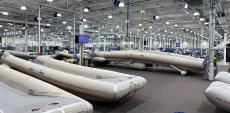

24/7 AOG Critical Response
Hotline![]() UK +44 1403 798888US +1 877 780 2008
UK +44 1403 798888US +1 877 780 2008
Our award winning global AOG service is manned 24 hours a day, 365 days a year.
Please call +44 1403 798888 or email aog@ajw-group.com.

21 Mar 2024

In the rare event of an emergency cabin evacuation, a successful exit depends on how well the exit doors and their built-in escape slides and actuators perform. So, how do OEMs and MROs ensure that escape doors and equipment are manufactured and maintained to the highest industry standards? Aviation Week investigate in their latest article.
In a recent article for Aviation Week, Paul Seidenman and David Spanovich speak to industry experts about the manufacture and maintenance of cabin emergency escape systems. Investigating the approach of MROs, they ask AJW Technique’s SVP Operations, Louis Philippe Mallette about technological improvements in escape slides.
Mallette comments that while the fundamental design concept of escape slides has remained consistent across newer aircraft, there have been noticeable improvements, primarily involving materials and weight reduction.
He states that “Advancements in material technology have led to lighter systems and quicker deployment during emergencies. This is allowing manufacturers in some cases to extend maintenance intervals to five years while still demonstrating the required reliability over that period, thereby reducing operators’ costs.”
Despite these advancements, he says, the interface between components and the main and over-wing exits still follow traditional designs. “Typically, the evacuation slide is still located on the door, maintaining consistency across generations of aircraft.”

Seidenman and Spanovich continue, asking Mallette about the overhaul life of escape slides, and the issues MROs typically see with slides that are brought in for unscheduled repairs.
Mallette stresses that as long as the slides are undisturbed, the evacuation systems are traditionally very reliable and will typically stay on wing for their full scheduled overhaul life of 3-5 years.
However, he notes that “Where we do see issues is when they are disturbed for some reason by people servicing the aircraft, which is very often the case with front door systems and may result in an unplanned deployment.” This is a less frequent occurrence now that airframers have taken steps to reduce these instances.
He goes on to say that door-mounted packboards and slide actuators can be particularly vulnerable to damage during scheduled airframe inspections, especially if technicians are careless.
When asked if packboards and actuation components could be trending toward fuselage installations and away from the exit doors due to the risks of damage, Mallette replied that they were not.
Elaborating, he says AJW Technique technicians have observed that current designs remain consistent, with only one notable deviation being found in overwing slides, where exit doors are smaller and have insufficient space for a door-mounted slide.
Finally, Mallette is asked what happens during an evacuation system inspection. He focusses his reply on two main components - the inflatable slide and the air system that houses the cylinder containing the compressed gas and aspirators.
“During scheduled maintenance, AJW will perform an inspection and overhaul of the cylinder assembly” he says. “Part of this process involves hydrostatic testing, which is a critical process used to evaluate the integrity of pressure vessels such as cylinders, and to detect any potential leaks or structural weaknesses.”
For the slide, the inspection focuses on its general condition - in particular looking for porosity, tears and leakages - including conducting an overpressure test. He asserts that “Minor tears can be repaired; however, with the older slides, we need to replace the full inflatable system.”